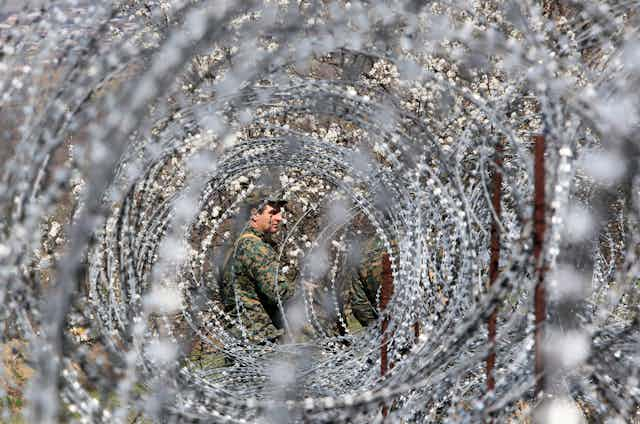Beginning in 1989, nationalist sentiment swept across the former Soviet Union, leading to outbreaks of inter-ethnic violence in many regions.
The Caucasus, a mountainous area west of the Caspian Sea, is home to more than three dozen different ethnic groups and was struck particularly hard. Major groupings include Georgians, Armenians and Ossetians — all predominantly Christians — and Circassians, Chechens, Avars and various Turkic-speakers, who are mainly Muslims. Prior to the Soviet period, most of these peoples lived in relative autonomy, their loyalties primarily attached to clans rather than governments.

But some of the worst tension was found in Georgia, where a newly elected government under ultra-nationalist Zviad Gamsakhurdia sent waves of fear through the republic’s non-Georgian populations —especially Abkhazians on the western coast and Ossetians, who occupy both the north and southern slopes of the central Caucausus.
At a rally in Gori (Joseph Stalin’s birthplace) in November 1989, Gamsakhurdia told the crowd:
“Get rid of Ossetians in responsible positions —police and teachers first. I authorise you to search their homes and confiscate any weapons, daggers, big knives or axes you find. There will be an end to South Ossetia…”
Increasingly hysterical Georgian-language media simultaneously provoked anti-minority hooliganism by Georgian gangs and reactions from the victims, including popular resistance to the attacks and moves by the Abkhazian and South Ossetian regional governments to upgrade their administrative status to acquire more autonomy.
Georgia reacted by imposing harsh repressive measures, including the abolition of the South Ossetian Autonomous Oblast as an administrative unit in December 1990.
Georgia sent in troops
Clashes between rival militias broke out the following day in the South Ossetian capital of Tskhinval, and Georgia sent in some 6,000 troops to occupy the city beginning in January 1991.
Russia sent in peacekeeping forces, but they tended not to get involved on either side. Tens of thousands of refugees fled their homes, mainly to North Ossetia, which remained administratively part of Russia. Georgians living on Ossetian territory likewise fled to Georgia proper.
Following Georgia’s independence from the crumbling U.S.S.R. in April 1991, Gamsakhurdia made total assimilation or expulsion of Georgia’s ethnic minorities a central part of his policy. Tensions continued throughout the summer, and the South Ossetian parliament formally declared its independence from Georgia in December of that year. Sporadic fighting between Georgian and South Ossetian militias continued until the signing of a Russian-brokered ceasefire at Sochi in March 1992.
Throughout the ensuing years, the Republic of South Ossetia survived as a de facto independent state, their borders guarded by a contingent of Russian, South Ossetian and Georgian peacekeeping troops.

But the election of integrationist president Mikhail Saakashvili in January 2004 once again sounded the alarm for Ossetians. After four tense years under the new president, violence once again broke out in April 2008. Flare-ups continued throughout the summer, until August, when Saakashvili made a televised address to assure Ossetians that they were brothers and had nothing to fear from Georgia.
A few hours later, he sent in 1,500 troops to occupy Tskhinval, causing a renewed outbreak of war.
South Ossetia recognized
Russian troops moved in two days later to stop the fighting, and a ceasefire was signed on Aug. 12, 2008. Russia formally recognized the Republic of South Ossetia as an independent state nine days later.

Since the end of the 2008 war, the border between South Ossetia and Georgia has been definitively sealed, with the only access in and out of the country through the Ruki tunnel linking it to the Russian Republic of North Ossetia-Alania to the north. There is no airport within the country.
With a population reduced to little more than 53,000 due to war and emigration, South Ossetia is entirely dependent on Russia both economically and diplomatically. Besides Russia, only four other United Nations members have recognized its independence: Nicaragua, Venezuela, Syria and Nauru.

South Ossetia has virtually no industry, and it can scarcely even benefit from its agricultural economy because of the bureaucracy involved in exporting produce to Russia. And yet, thanks to Russian economic assistance, the country is surprisingly well-developed, with an impressive new university building, rebuilt government offices, a hospital and even a luxury hotel nearing completion.
The Ossetians are speakers of an ancient east Iranian dialect descended from the language of the Scythians. Their unique culture is most visibly preserved in the heroic epic known as the Nart sagas, which are comparable to the works of Homer or the Indian Mahabharata in their style, scope and content.
In contrast to North Ossetia, where Russian is dominant, in South Ossetia, the language and cultural traditions are alive and well.
So why has the international community, for the most part, withheld recognition of the South Ossetian state?
The main reason would seem to be an unquestioning support for Georgia and fear of Russian expansionism. But because South Ossetians will never agree to re-integration with Georgia, any policy based on such an outcome is destined to fail.
In fact, international recognition of South Ossetia, which would allow for increased economic, political and cultural contacts with the outside world, would be the most effective way to prevent the country eventually integrating into Russia — as well as the best guarantee for the preservation of its unique language and culture.

